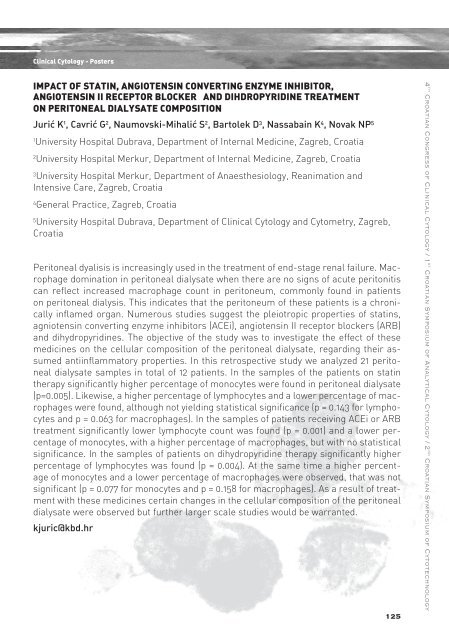4. Hrvatski kongres kliniËke citologije 4th Croatian Congress ... - Penta
4. Hrvatski kongres kliniËke citologije 4th Croatian Congress ... - Penta
4. Hrvatski kongres kliniËke citologije 4th Croatian Congress ... - Penta
You also want an ePaper? Increase the reach of your titles
YUMPU automatically turns print PDFs into web optimized ePapers that Google loves.
Clinical Cytology - Posters<br />
IMPACT OF STATIN, ANGIOTENSIN CONVERTING ENZYME INHIBITOR,<br />
ANGIOTENSIN II RECEPTOR BLOCKER AND DIHDROPYRIDINE TREATMENT<br />
ON PERITONEAL DIALYSATE COMPOSITION<br />
Jurić K1 , Cavrić G2 , Naumovski-Mihalić S2 , Bartolek D3 , Nassabain K4 , Novak NP5 1University Hospital Dubrava, Department of Internal Medicine, Zagreb, Croatia<br />
2University Hospital Merkur, Department of Internal Medicine, Zagreb, Croatia<br />
3University Hospital Merkur, Department of Anaesthesiology, Reanimation and<br />
Intensive Care, Zagreb, Croatia<br />
4 General Practice, Zagreb, Croatia<br />
5University Hospital Dubrava, Department of Clinical Cytology and Cytometry, Zagreb,<br />
Croatia<br />
Peritoneal dyalisis is increasingly used in the treatment of end-stage renal failure. Macrophage<br />
domination in peritoneal dialysate when there are no signs of acute peritonitis<br />
can reflect increased macrophage count in peritoneum, commonly found in patients<br />
on peritoneal dialysis. This indicates that the peritoneum of these patients is a chronically<br />
inflamed organ. Numerous studies suggest the pleiotropic properties of statins,<br />
agniotensin converting enzyme inhibitors (ACEi), angiotensin II receptor blockers (ARB)<br />
and dihydropyridines. The objective of the study was to investigate the effect of these<br />
medicines on the cellular composition of the peritoneal dialysate, regarding their assumed<br />
antiinflammatory properties. In this retrospective study we analyzed 21 peritoneal<br />
dialysate samples in total of 12 patients. In the samples of the patients on statin<br />
therapy significantly higher percentage of monocytes were found in peritoneal dialysate<br />
(p=0.005). Likewise, a higher percentage of lymphocytes and a lower percentage of macrophages<br />
were found, although not yielding statistical significance (p = 0.143 for lymphocytes<br />
and p = 0.063 for macrophages). In the samples of patients receiving ACEi or ARB<br />
treatment significantly lower lymphocyte count was found (p = 0.001) and a lower percentage<br />
of monocytes, with a higher percentage of macrophages, but with no statistical<br />
significance. In the samples of patients on dihydropyridine therapy significantly higher<br />
percentage of lymphocytes was found (p = 0.004). At the same time a higher percentage<br />
of monocytes and a lower percentage of macrophages were observed, that was not<br />
significant (p = 0.077 for monocytes and p = 0.158 for macrophages). As a result of treatment<br />
with these medicines certain changes in the cellular composition of the peritoneal<br />
dialysate were observed but further larger scale studies would be warranted.<br />
kjuric@kbd.hr<br />
125<br />
4 th <strong>Croatian</strong> <strong>Congress</strong> of Clinical Cytology / 1 st <strong>Croatian</strong> Symposium of Analytical Cytology / 2 nd <strong>Croatian</strong> Symposium of Cytotechnology


